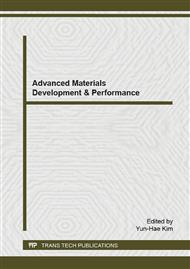p.69
p.73
p.77
p.82
p.88
p.92
p.96
p.100
p.107
Wear Resistance Properties of Nylon-SiC Hybrids Composites
Abstract:
For marine and offshore applications, the materials specific strength is vital parameter in improvisation of flexible riser parts for deep sea exploration. Nylon is prospective materials for riser application due to its good degree of flexibility and excellent barrier properties, but with the disadvantage of limited working temperature and low wear resistance. The incorporation of fibrous and/or particulate reinforcement is significant to investigate polymers utility for extreme environment condition, such as; elevated temperature and high applied load. Previously it has been reported on the utilization of fibrous(carbon/glass/Aramid) and particulate fillers to improve thermoplastics properties but at the cost of detrimental flexibility. Ceramics in the form of whiskers (high modulus and rigid unbreakable rods) are the potential fillers/reinforcements for polymer due to their excellent properties, such as; high toughness, wear resistance, remarkable thermal and dimensional stability. Present work is aimed to utilize the silicon carbide (SiC) whiskers as reinforcement for Polyamide 11 (PA11) to improve its mechanical, thermal and wear resistance properties. The SiC whisker filled polymer has shown significant improvement in properties of PA11 to employ it as potential materials for flexible riser applications.
Info:
Periodical:
Pages:
88-91
Citation:
Online since:
June 2015
Authors:
Keywords:
Price:
Сopyright:
© 2015 Trans Tech Publications Ltd. All Rights Reserved
Share:
Citation:


